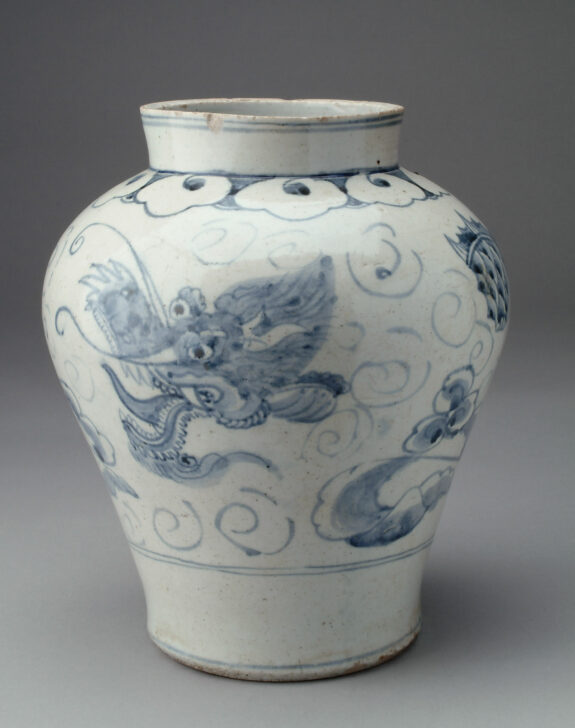Blue-and-white jar with dragon-and-cloud design
Korean

Description
March 28, 2009
A vivacious and witty dragon plays hide and seek among swirling clouds on the surface of this jar. The dragon’s head and claws are detailed, while the rest of his body is left to the imagination. In Korea, the dragon is a symbol of rain, fertility, and heaven—and, by extension, the ruler. Only the king could use dragon designs, so this jar was probably used at court.
Porcelain dragon jars decorated in underglaze cobalt blue became popular in the late eighteenth century. Some larger jars measure over twenty inches tall and show complex designs. This one is half the size and more simple in decoration, which argues for a creation date in the nineteenth century. A notation on the underside indicates that this vessel was made at the official Bunweon kilns in Gwangju. Even without the marker, the lavish and skillful use of cobalt decoration on the jar suggests that pedigree.
(Label for UMMA Korean Gallery Opening Rotation, March 2009)
Subject Matter:
Dragon and cloud design.
Physical Description:
Large porcelain jar decorated with cobalt pigment under colorless glaze. Repeating clouds border the rim of the jar, while a dragon head and feet are depicted on the main body below. Two blue bands separate the design from the white base below, balancing the rim and bottom portion of the jar. The very tip and base of the piece are also marked with blue bands.
This is a blue-and-white jar with cloud and dragon designs which is tought to have been produced at Bunwon-ri, Gwangju-si, Gyeonggi-do around the year1883, when official court kilns there were privatized. The dragon is painted with cobalt on a large jar, but with only its head fully exposed and the body largely concealed by white clouds. This distinctive design is rarely found in blue-and-white porcelain. Two blue horizontal lines encircle the rim, while its shoulder features a yeoui-head band. It is glazed all the way down to the outer base, and coarse sand was used as kiln spurs, which leaves its mark on the foot rim. The Chinese character “白” (“baek;” white) is incised on the outer base. Specks of ash on the jar’s surface give it an overall pale yellow tint.
[Korean Collection, University of Michigan Museum of Art (2014) p.168]
Usage Rights:
If you are interested in using an image for a publication, please visit https://umma.umich.edu/request-image/ for more information and to fill out the online Image Rights and Reproductions Request Form.